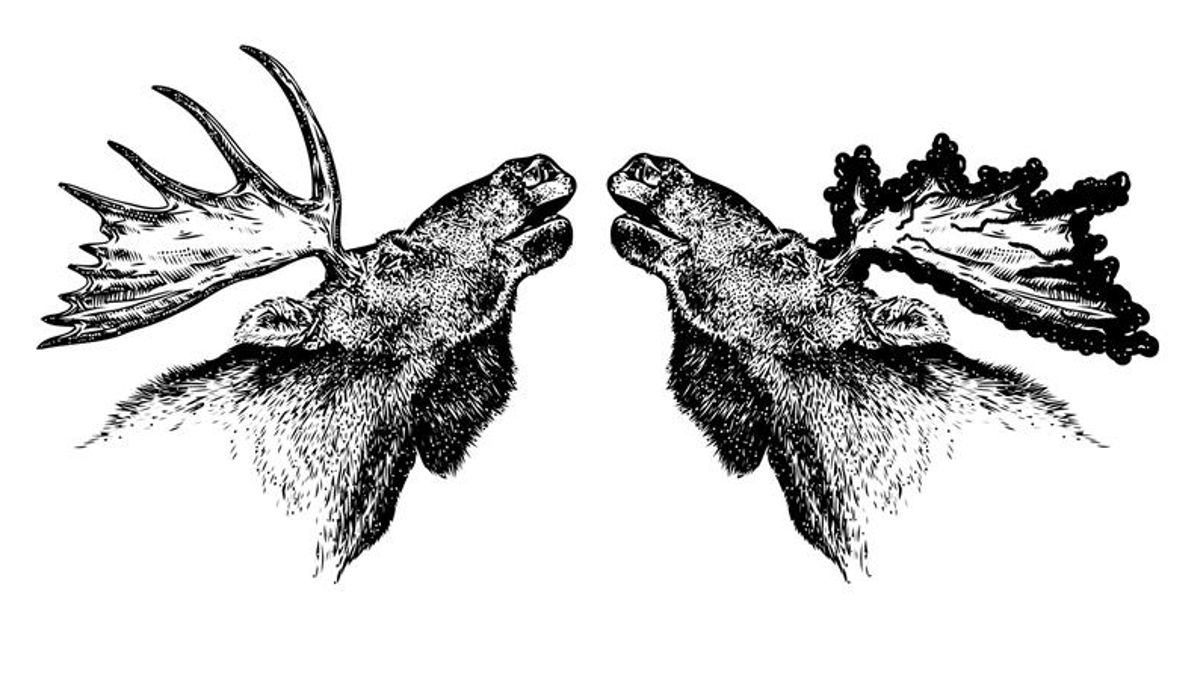
Have you ever heard of a moose with so-called “Devil’s Antlers”? Although it may conjure images of some monstrous misshapen animal lurking in the wilderness, the term actually appears to refer to a real phenomenon that further demonstrates how cool antlers are.
How to make antlers
If you look for this term online, you will find only a few references to it and annoyingly few verifiable images. However, the moose with Devil’s Antlers does appear to be real. It seems it is a colloquial term that refers to bulls that have grown abnormal and typically ugly antlers, which do not shed.
Unlike cattle, sheep, and goats that keep their horns, moose – the largest member of the deer family (Cervidae) – shed their antlers every year. This is because antlers are not fused to the animals’ skulls in the same way that horns (made of bone and keratin) are. Instead, bull moose grow their antlers during the spring months and use them to fight and attract females (typical male stuff) in autumn.
After this, the bulls shed their antlers which relieves them of up to 27.2 kilograms (60 pounds) of weight, and helps conserve energy through the cold winters.
Antlers grow ridiculously fast. In fact, they are among the fastest growing tissues in the animal world. For instance, white-tailed deer antlers can grow around a quarter of an inch a day, whereas elk can grow theirs at around an inch a day.
When a male moose reaches around a year of age, it will start growing its first antlers, which become more impressive and elaborate in appearance with each subsequent shed-and-grow cycle.
When they start to appear, new antlers grow in a velvety skin that helps to nourish them. This process is triggered by increasing daylight which leads the animal to produce more testosterone. Then, around September, the bull experiences a further surge in this hormone, which leads to the moose shedding the velvet to reveal its spectacular bony headwear.
However, in rare situations, this process goes wrong, and the animal grows weird, disfigured antlers that neither suit their purpose nor shed at the end of the mating season.
What the devil is it all about?
The effect is caused by a lack of testosterone in the animal, caused by castration or some hormonal dysfunction. When it occurs, the moose will shed its existing antlers and then grow new and deformed ones that will not shed, as testosterone is needed to start this process.
This phenomenon has several names depending on where you are. Within some circles in North America and Canada, it is referred to as Devil’s Antlers, but in some cases, especially when concerning deer, the antlers form tumor-like masses called “perruque head”. This latter name is derived from the fact that the failed antler looks like an old fashioned perruque wig. They are sometimes referred to as an “antleroma”, which combines the English word “antler” with the Greek “oma” for “tumor-like”.
There are also what’s referred to as “cactus antlers” and velericorn antlers. Unfortunately, images of these antlers are rare to find and those that do exist are usually exhibited by animals that have just been shot, so we will spare readers the experience of seeing that. But a quick internet search will give you an idea.
Interestingly, this bizarre phenomenon is not a new discovery. Aristotle even described it in his History of Animals, which was written in the fourth century BCE.
So it seems the mystery of the Devil’s Antlers is not all that unusual after all, even if photographs of this bizarre form of growth are frustratingly difficult to come by.
Source Link: The Mystery Of Moose With “Devil's Antlers”: What Does Science Say?